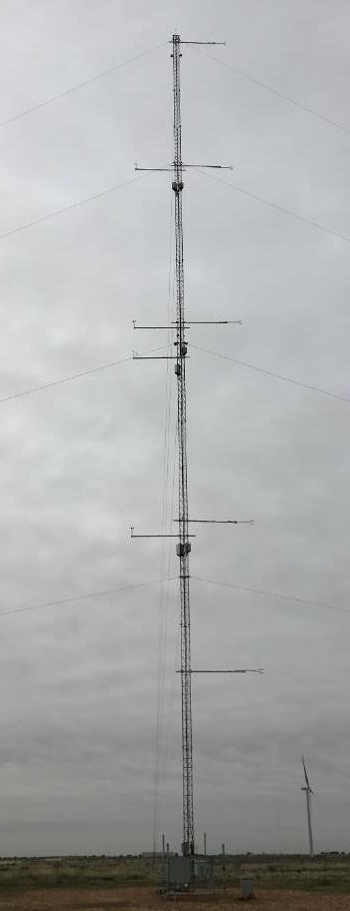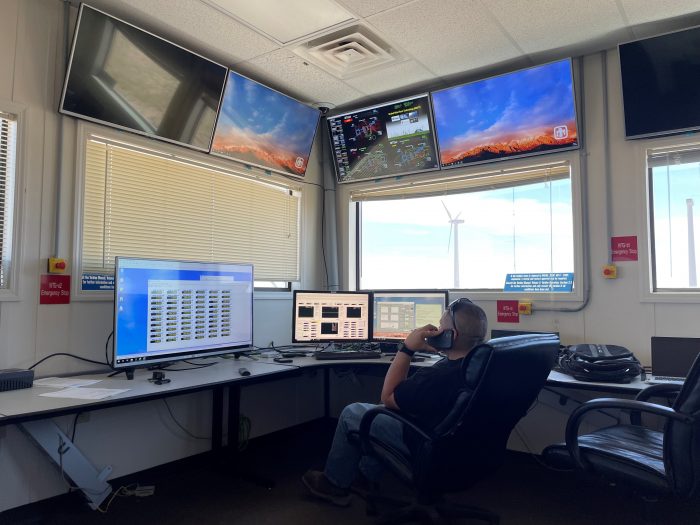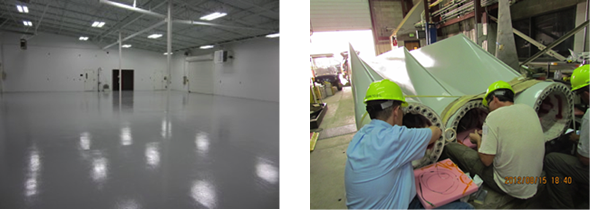Enabling rapid, cost-effective research and making unique assets available to improve wind plant performance, advance technology, and build trusted partnerships.
The Sandia Scaled Wind Farm Technology (SWiFT) Facility, in Lubbock, Texas, is a state-of-the-art public research and training facility funded by the U.S. Department of Energy. SWiFT partners with industry and academia to:
- Test industry technologies
- Enable workforce development programs
- Drive rotor advancements and testing
- Advance renewable energy grid integration and security
At the Scaled Wind Farm Technology Facility (SWiFT) in Lubbock, Texas, Sandians partner with other researchers to study the interaction of multiple wind turbines in a wind farm. Funded through the Department of Energy’s Wind Energy Technologies Office, SWiFT allows for rapid, cost-efficient testing and development of transformative wind energy technology, with emphasis on improving wind plant performance. Advanced testing and monitoring at SWiFT will help researchers evaluate how larger wind farms can become more productive.
The site includes two V27 research turbines deployed by the Department of Energy and Sandia, and a third V27 turbine belonging to Vestas, a leading wind turbine manufacturer.
In its second decade of existence, SWiFT is meeting the current needs of the wind industry by providing open access to an operational wind farm, and is positioned to anticipate the research and development needs of the nation’s renewable energy infrastructure and industry. The site is strategically located in Lubbock, Texas, a region with a high wind resource and low turbulence, which is ideal for research. Test-scale turbines, the ability to facilitate the installation of partner test units, and other site facilities enable Sandia and its partners to conduct both collaborative and proprietary testing. Sandia also has developed highly effective Environmental, Safety and Health (ES&H) standards that are easily integrated into all aspects of the site.
On this page:
Facility Details
SWiFT Turbines Allow Unique Access Tailored to Individual Needs
SWiFT consists of three research-scale wind turbines (modified Vestas V27s). The turbines are capable of full variable-speed, variable-pitch operation with rotational speeds ranging from 0–55 rpm, rotor blades of 13 meters in length, and a maximum power rating of 300 kW. Highly experienced and passionate technologists and engineers support the SWiFT Facility and are focused on partnering for success. The SWiFT Facility project team has access to Sandia’s vast network of Subject Matter Experts (SMEs), and can provide myriad additional testing capabilities in Albuquerque, NM. Sandia has also developed a Power Hardware-in-the-Loop simulator in Albuquerque that is used at the Distributed Energy Technologies Lab (DETL) for controls and cyber simulation research. This combination of hardware and software also allows researchers to run control software prior to deployment at the SWiFT Facility for quality and safety assurance.

Meteorological Towers
The site provides reliable data from two, a 60-meter tall anemometer towers instrumented with sonic and cup anemometers. The research-grade three-dimensional sonic anemometers measure the inflow at six levels, including one that is a blade length above the rotor.
Capabilities of the site include:
- Testing industry technologies
- Enabling rapid innovation at scale at a competitive cost
- Scheduling the crane is reduced from months-ahead to days-ahead
- Failure risk is substantially less
Control Building
A state-of-the-art control building, located at the facility’s northwest corner, contains 640 square feet of computing space for wind-turbine control, including two offices for proprietary work and an electronic troubleshooting shop. A fiber controller allows for tremendous data transfer capability and flexible site network reconfiguration.

Full Instrumentation for Detailed Data Acquisition
The turbines are heavily instrumented with state-of-the-art control and data-acquisition systems featuring GPS-based, site-wide time synchronization. The site instrumentation provides hundreds of channels of structural and aerodynamic data to fully understand the instantaneous state of the rotor, wind turbines, and wind farm for advanced control strategies, such as rotor-based active aerodynamic load control. Sandia has also developed a Power Hardware-in-the-Loop simulator in Albuquerque, NM, that is used at the Distributed Energy Technologies Lab (DETL) for controls and cyber simulation research. This combination of hardware and software also allows researchers to run control software prior to deployment at the SWiFT Facility for quality and safety assurance.
Assembly Building
The assembly building is available for experimental preparation of rotors and other components, and includes a 5,500 square foot, environmentally controlled high-bay assembly area with machining capabilities. The machining area includes a lathe, multiple mills, drill press, welders, and a full complement of tooling to produce unique and on-demand parts.

Partnership Opportunities
Resources:
- Steps to Commercialization
- Sandia’s Technology Partnership website, including partnerships for business, industry and nonprofits
Capabilities of the Site Include:
Testing Industry Technologies
- Component testing of operations and management (O&M ) technologies such as drones, crawlers, non-destructive inspection (NDI), cleaning and repair (tower scrubber), and robots
- Access to wind turbines and other site assets
- Green technology, grid resilience, and cybersecurity testing, with interconnection with the Texas Tech University Global Laboratory for Energy Asset Management and Manufacturing (GLEAMM)
- Sandia partner Group NIRE brings site development expertise for the installation of test equipment on the Reese Technology Center
Enabling Workforce Development Programs
- Provide access to relevant scale operational equipment for partner-provided hands-on training
- Make assets available for climb and rescue training and wind turbine basic orientation training
- Partner with regional entities to help build a safe and strong renewable energy workforce for the future
Rotor Advancements and Testing
- Experience with design, manufacturing, and operation of rotor experiments
- Relevant scale and lower costs, experienced and agile operating model to seamlessly integrate with partner needs and requirements
- Highly trained, skilled and experienced technologists, who are well-versed in instrumentation, data acquisition, and testing
SWiFT Operations
Sandia National Laboratories’ Wind Energy Design and Experiment department operates the Scaled Wind Farm Technology (SWiFT) Facility for the U.S. Department of Energy’s Wind Energy Technologies Office (WETO). Sandia’s SWiFT site team performs routine maintenance, modifications, testing, and experiment setup and execution on SWiFT’s three research-modified Vestas V27 wind turbines and two heavily instrumented meteorological (MET) towers. The team is supported by staff located in Albuquerque, NM. Sandia operates its turbine site out of a specially designed and modern control building, and conducts instrumentation installations and experiment setup in its environmentally controlled high bay located on the Reese Technology Center’s main campus.
The SWiFT Facility has a rich history of supporting wind-plant and turbine research development as a rapid technology accelerator to lower the levelized cost of wind energy. The facility continues to test and develop prototype technology before transferring to industry in support of DOE objectives and industry needs. The Sandia wind project team is focused on facilitating user needs and providing a secure and unobstructed location for collaborative projects with industry, academia, and other national laboratories as a world-class test bed.
Test Site Operations & Maintenance Safety
Site Equipment, Environmental Compliance, and Safety
Sandia has created a robust environmental, safety, and health (ES&H) framework for operating and working alongside partners at the Scaled Wind Farm Technology (SWiFT) Facility at the Reese Technology Center in Lubbock, Texas. Sandia staff, in collaboration with a breadth of highly knowledgeable and experienced subject matter experts, have developed and foster a sustainably strong safety culture, with safety programs and training tailored to the site, operations, and working seamlessly with facility users and collaborators.
Sandia is focused on sustaining a safe, world-class renewable energy research and testing facility that minimizes risk to personnel performing work or visiting the SWiFT Facility. By making safety our highest priority, Sandia integrates continuous improvement and a timeout policy which empowers all personnel on site with safety ownership, regardless of employer or affiliation. We live by the motto, “One Team, One Mission,” meaning that everyone is engaged in maintaining a safe and environmentally friendly user facility.
Test Facilities Capital Equipment
Sandia has made smart strategic capital investments to increase reliability and resiliency at the SWiFT Facility and in all of our activities, ensuring its readiness for partnership opportunities.
Sandia and the SWiFT project team continuously review the capabilities of the site with regard to the current and future needs of industry and academia, as well as alignment with the goals of federal, state, local, and tribal governments. The U.S. Department of Energy, through Sandia National Laboratories, is making it possible for entities looking for a state-of-the-art facility to conduct testing, validation, training, and proof of concept to use this one-of-a-kind, world-class wind research and microgrid complex to advance technologies and meet the demands of our energy infrastructure.



